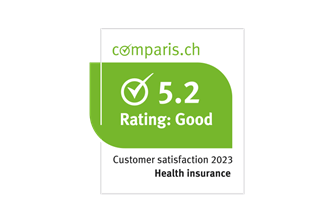
Electronic data interchange for service providers
Electronic invoicing
SWICA allows you, the service provider, to issue electronic invoices using the tiers payant (TP) system. This means that SWICA settles your invoices directly and claims back any co-payments from the patient. This brings a number of advantages:
- System-based invoicing is cheaper than using the postal system.
- SWICA tends to pay invoices faster and bears the collection risk in relation to patients.
- There are efficient communication channels in place between the payer and the service provider.
Are you interested in securing these advantages for your organisation? You will find further details about getting started and the invoicing process below.
Electronic invoicing
These are the requirements that must be met in order for you to transmit your invoices using EDI:
- You must have a valid, active Global Location Number (GLN). This serves as your address within the electronic space. If you do not yet have a GLN, you can request one directly from the Refdata foundation (in German).
- You must have a valid, active entry in the Sasis (in German) paying agent register. The PAR number is mandatory for some aspects of the technical standard and for processing in our system.
- The practice software you use must be capable of creating electronic invoices that comply with the specifications of the Forum Datenaustausch (Information Exchange Forum, in German). Alternatively, you can work with a third-party provider that takes care of this for you.
- You must work with an intermediary affiliated with the SWICA system landscape, which transmits the invoices to us.
In addition to the technical requirements, there are also some organisational requirements that are relevant for electronic invoicing:
- In order for the technical standard to be created and invoices to be processed automatically, there must be a contractual rate agreement in place between you and SWICA.
- We ask that you check the patient's insurance card for identification purposes and communicate the identification number shown on the card to us. This ensures that we only receive invoices relating to SWICA customers.
- SWICA currently accepts electronic invoices according to the Forum Datenaustausch «generalInvoiceRequest450» standard or higher.
- The only permitted payment option is «esrQR», as banks are no longer able to process payments based on the old payment slip standards.
- If supporting documents are to be submitted, please transmit these in the form of «base64-encoded» files of the type «application/pdf» (not as URLs).
- Please confirm the schema validity of the XML invoices created before transmission, as any that do not conform cannot be processed through the digital channel.
Have we persuaded you that switching to electronic invoicing is the right choice for you? Then we'd love to help you take the next steps.
- Check that all the requirements for switching are in place.
- Generate test electronic invoices in conjunction with your software partners and submit them to SWICA in test mode.
- Complete the contact form, and we'll be in touch with you.
Contact for questions about electronic invoicing
Do you need further information about electronic data interchange with SWICA? Simply send us a message using the contact form.
Go to contact form
Electronic documents
As clarifications can sometimes take a long time, we use the «pending» function. If you or your collection agency have activated this module in the accounting software, we will request via the electronic interface that reminders be stopped.
In order to avoid queries and incorrect payments, it is important that invoices set out the services provided using the correct tariffs and tariff codes. The tariff/tariff code combination enables the service to be identified. However, it is not always easy to determine the right tariff and tariff code, particularly for medications, consumables, aids and discretionary services. You can find a list of the tariffs applied in the Swiss healthcare system on the Forum Datenaustausch website (in German).
Please be aware that some tariffs apply only to certain laws, and that the same treatment may therefore require different tariffs to be used where provided in relation to different laws. Medications and medicinal products should ideally be registered with Refdata and HCI Solutions, enabling them to be invoiced using the GTIN (tariff 402) or pharmacode (tariff 400). These two identifiers enable items to be uniquely identified in the Swiss healthcare system.
For items that are not registered and for discretionary services, use the separate tariffs with tariff codes for other services:
- 406: Other services not defined in official tariffs (doctors, KVG/VVG)
- 407: Other services not defined in official tariffs (paramedicine, KVG/VVG)
- 940: Hospital tariff for other outpatient services
These tariffs must only be used where the «official tariffs» cannot be applied!
If you are unable to find a suitable service in the tariff system, your association may be able to provide more information. Some associations have published information about tariffs and invoicing on their websites. Some even offer telephone support.
For example, if only half a packet of a medicinal product was administered or prescribed, the quantity must be «0.5». For products that are listed in the medicinal products tariff (tariffs 400/402) and in the list of medical supplies and devices (Mittel- und Gegenständeliste, MiGeL, tariffs 452/454), the unit may vary between tariffs. The medicinal products tariff lists specific products that may contain multiple units. The MiGeL tariff is based on one unit in one product category.
Services provided in a couple, family or group setting are described in the section «Services provided to more than one person» below. The «quantity» field may not be rounded. You can find further information in the «Rounding» section below.
Source: XML standard 4.5, attribute «quantity»
A person's share of the service is invoiced using the divisor method, i.e. the value entered in the «quantity» field must be divided by the number of people. As the share is calculated using the quantity, the tax point or scaling factor need not also be divided by the number of people.
The group size must also be stated in the «group_size» field. This field is for information only and is not relevant for the calculation of the position amount.
Source: XML standard 4.5, attributes «quantity» and «group_size»
amount = external factor * quantity * TP * TPV * scale_factor
The tax point or price in the TP field (XML: unit) must exactly match the value in the tariff (no rounding or other deviations). For Tarmed calculations, the same procedure applies to the calculations for the medical part (amount_mt) and the technical part (amount_tt). The two amounts are then added together to arrive at the position amount (service_ex/amount).
The balance amount (balance/amount) is the sum of all position amounts. As these are all rounded to two decimal places, the balance amount is also to two decimal places. The balance amount due (balance/amount_due) is then calculated according to the following formula, and the result is rounded up or down as applicable.
amount_due = amount - amount_prepaid + amount_reminder
Source: XML standard 4.5, Purpose/About rounding
Source: XML standard 4.5, attribute «gestation_week13»
Source: XML standard 4.5, referrer
Contact for functional queries
If you have any queries about a service invoice or a rejection, please get in touch with the contact person named on the invoice or rejection. If no contact is specified, you can reach out to the Regional Head Office for your local area.
Go to SWICA locations




